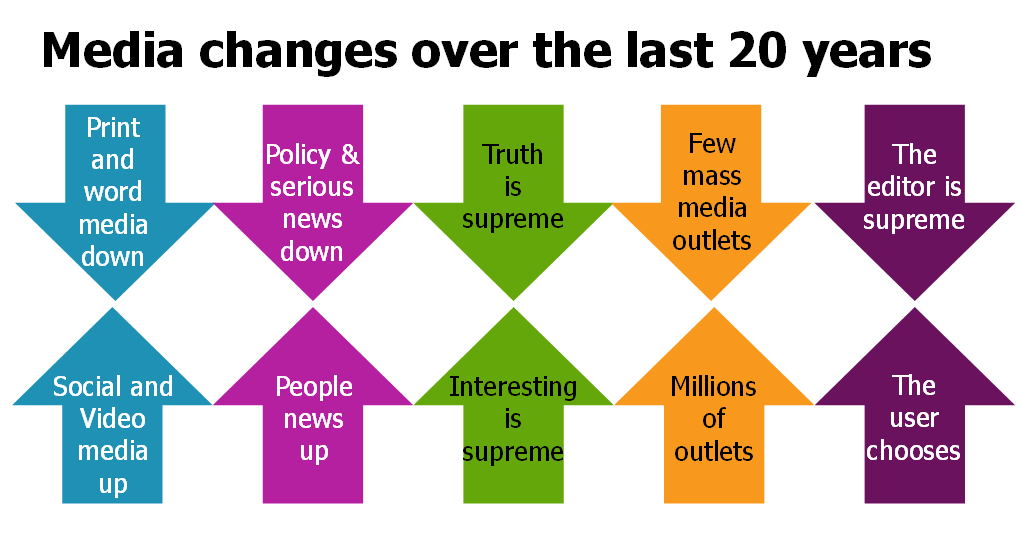Trend 1: Print and word media down, social and video media up
Trend 2: Policy and ‘serious news’ down - people and personalities are the new stars
Trend 3: Truth and facts in decline - what’s interesting is now what really matters
Trend 4: Established mass media outlets in decline, while social media outlets soar
Trend 5: The all-powerful newspaper editor is a dying breed: the user chooses everything
Winners and losers in the brave new world
Some of the winners are:
- Celebrities. Celebrities and innovative individuals are the real winners. Celebrities are able talk direct to their fanbase if they so wish unhindered by the editing of others.
- Pluralism. It’s probably fair to say that the world of social media has allowed a blooming of an astonishing breadth of opinions. Not all of it very savoury, and some of it pretty bonkers.
- Innovators. To really succeed in social media then be its vital to be innovative, to be direct, or charismatic, or have great stories to tell.
Some of the losers are:
- The dull. Those organisations with dull (even if important) messages are often the losers, essentially if their work can’t be distilled into a few short sentences. It’s no coincidence that big celebrities (Katy Perry, etc) have far more followers than the biggest companies (Starbucks, Xbox and Samsung all have around 11/12 million). In turn these are better than the big charities who have, at best, around a few million followers (Unicef with 7 million and WWF with 4 million)
- The slow. Any organisation who wants to flourish on social media need to respond quickly and 24/7.
- The formal. If an organisation makes it social media output sound like a form of corporate-speak it will be hard for it to get traction or generate interest.
What does all this mean for charities?
- Be personal. Scratch beneath the surface of any charity, large or small, and there are a raft of people doing amazing work. Those people are the ones who should be the epicentre of social media feeds, rather the anonymous messages/third person speak from a corporate HQ.
- Tell stories. The stories that charity staff, volunteers and beneficiaries have to tell could be inspirational and go to the heart of a charity’s mission and work. It is stories that appeal to people’s heart and open their wallets. It is stories, rarely stats, that make supporters.
- Use photos and videos. Here’s a simple test. How many photos are there on your website homepage of real people with their stories? And now how many videos? In a world where the fastest growing social media is the photo-based Instagram, it’s amazing how many charities still let words and anonymous photos dominate their websites and media output.
- Take risks. Nobody breaks the mold by doing what everybody else has done.
Thansk Joe for, as always
Thansk Joe for, as always giving us a sharp perspective on the cahnges that come oabout in comms and the media over the last 20 years. Like you, having worked in non-profit fundraising for over 35 years I recall when the fax machine was the equivalent of a tweet/emnai/social media posting of a press release all-in-one. Bike and motorbike couriers in London carrying printed photos taken on SLR cameras, developed and printed were our means of getting an image to the media for them to MAYBE once in a wheile publish...which meant printing in Fleet Street still in those days!!
Really interesting review of
Really interesting review of seismic shifts in the media landscape. Quite right that this world has transformed and charities need to transform to keep up. The story aspect plays to the heart of what we do - if we can't come up with inspiring stories then we need to pack up and go home!
Excellent article, neatly
Excellent article, neatly encapsulating the shifting media landscape. It's probably a good thing that charities have been insulated to a degree from some of these effects due to their older donorbases adopting social media at a slower rate than younger audiences but you are right to highlight that new tactics required to engage the hoped for next generation of support.
I think the other big
I think the other big development, which arguably goes against some the main points in this article, is the strengthening of specialist trade media. Often this is the one part of the more old-fashioned media that is actually doing better as it remains funded by niche audiences or businesses interested in receiving industry news. A lot of news stories are now broken by specialist press which then make their way into mainstream news. In healthcare, for example, a lot of stories are generated by outlets like the Health Service Journal or the British Medical Journal which seem to be thriving publications despite the wider backdrop affecting more generalist national media.
I recommend that everyone
I recommend that everyone reading this article read 'New Power' By Jeremy Heimans https://www.penguinrandomhouse.com/books/534179/new-power-by-jeremy-hei…


